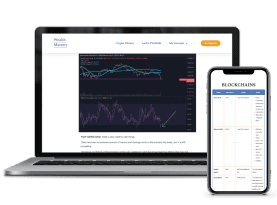How On-Chain Analytics Will Disrupt Business Reporting Forever

On-chain analysis is one of the most powerful tools in web3.
It allows us to dive deep into companies, projects, DAOs, and more to uncover the trends, user activity, financial health, and overall performance of a particular entity.
It gives power back to the people where previously most business data was locked tightly behind private servers.
But times are changing.
In this Deep Dive, the team at Web3 Academy breaks down:
- What on-chain analytics is and what’s wrong with current business reporting
- The main ways on-chain analysis will improve data access
- How we can leverage on-chain analysis to improve our decision-making and investing
Let’s go.
What Is On-Chain Analytics?
On-chain analytics involves analyzing transactions and other data recorded directly onto a blockchain – an open, permissionless, and transparent ledger.
This includes tracking token movement, volume of transactions, and identifying patterns and trends across blockchain use cases.
For example, we can view and analyze any of the on-chain data from OpenSea, such as its monthly fees generated or NFTs sold.
Being able to understand, analyze, and ultimately turn on-chain data for protocols, applications, collections, and companies into valuable insights will be the superpower in the coming decades.
Rather than speculating, it allows you to understand exactly what’s happening in the space to make rational investment decisions.
But before you get too bullish about the benefits of on-chain analytics, just keep in mind that it’s tricky – especially if you’re not a technical person.
That’s why at Web3 Academy, we created PRO to do this analysis for you. We combine our industry insights with on-chain analysis to deliver weekly reports packed with actionable insights about where you should invest and build.
Buckle up. This article will turn you bullish af.
And in case you want a taste of Web3 Academy PRO, we’ll provide all Wealth Mastery readers with an exclusive 7-day free trial!
Hurry though. It’ll expire by end of this week (5th of March) 👉 Get Web3 Academy PRO Trial
The Current State of Business Reporting
In the current state of business reporting, traditional methods such as financial statements and annual reports rely on manual processes and data entry, which can lead to errors, manipulation, and delays.
Other issues include:
- Lack of transparency: Some companies are not transparent in their reporting, which makes it difficult for stakeholders to understand the true financial health of the business. On top of this, private companies, like Twitter, or governments aren’t obligated to report their financial metrics.
- Bias: There is potential for bias in business reporting, either intentionally or unintentionally. For example, a company may be more likely to highlight positive information and downplay negative information in its reports.
- Timeliness: Financial reports may not be published in a timely manner, which can make it difficult for stakeholders to make informed decisions.
- Lack of standardization: There is a lack of standardization in the way that companies report their financial information, which makes it difficult to compare the performance of different businesses.
However, blockchains offer a solution to these issues by providing a tamper-proof record of real-time activity that can be easily tracked and analyzed.
How On-Chain Analysis Will Change Business Reporting
On-chain transactions give us an insider’s view of companies, protocols, NFT collections, and even blockchains themselves.
This benefits users, investors and entrepreneurs as they can easily analyze an entity of their choice at any time, helping them make better business & investment decisions.
Some other reasons include:
1. Increased Transparency and Accountability
On-chain analytics increases transparency and accountability by allowing us to analyze data recorded directly onto the blockchain.
This includes seeing the number of users interacting with a business and their financial data such as treasuries, balance sheets, and transaction history.
This level of visibility is important for building trust in the business and ensuring it operates as it should.
Without this transparency, situations like the one with FTX can occur where authenticity is based solely on persona.
On-chain data can help identify risky operations more easily than relying on tweets.
2. More Accurate and Up-to-Date Data
On-chain analytics is also changing business reporting by providing more accurate and up-to-date data.
You can even head to Dune right now and browse real-time dashboards that were created by fellow web3 DOers, such as the one below of X2Y2, who made a big splash in the middle of 2022 and managed to take 45% market share of total NFT volume.
What we are able to see on-chain though, is that when you account for wash trading, X2Y2’s market share isn’t as solid as we originally thought.
Real-time analysis of blockchain data allows businesses to make informed decisions and get a more accurate picture of their operations, particularly in rapidly changing industries like finance and technology.
This information is also valuable for investors, who can spot trends early, and creators/entrepreneurs who can use it to build new products or form partnerships with emerging projects.
3. Improved Efficiency and Cost-Effectiveness
On-chain analytics can automate data collection and analysis, saving businesses time and reducing their reliance on manual labor.
This could eventually replace traditional company reporting with data available at all times.
On-chain reporting can free up resources for other tasks such as strategy and innovation, and it can also improve standardization and reduce the cost of maintaining proprietary databases by transacting on a blockchain.
4. How We Can Leverage On-Chain Analytics to Improve Our Decision-Making
On-chain analytics provides access to data from large entities that would otherwise be inaccessible, allowing for more informed decisions about our own businesses or investments.
This is especially valuable in three areas
- On-demand financial reporting
- Marketing and customer analytics
- Supply chain management
Let’s break them down further.
On-Demand Financial Reporting
On-chain data provides stakeholders with a clear and complete view of a company’s financial health, preventing entities from hiding negative information.
Opaque financial reporting led to scandals at FTX and Celsius, which could have been prevented if they were operating solely on a blockchain.
Marketing and Customer Analytics
Right now the actions people take (whether that be posting on social media or buying a product) are hidden and stored in private company servers.
As web3 emerges, all actions, from social media posts to purchases, will be transparent, unlocking a wealth of data.
This includes analyzing customer wallets and identities, revealing valuable insights for companies and creators.
This is a massive win for builders as they can gain a greater understanding of their audience and community, allowing them to create experiences and forge partnerships that their customers benefit from.
For example, on Dune you can find on-chain analysis of BAYC holders and the other NFTs collections that they’re buying and selling.
This is potentially good investment information (if you believe BAYC holders are good investors) because you can literally analyze purchases in real-time, it can also be used by Yuga Labs, the owners of the project.
Yuga can easily see what BAYC holders are interested in and partner with other projects for experiences, giveaways, and more.
Supply Chain Management
There are several problems with current supply chain reporting that can be addressed through the use of on-chain analysis.
- Lack of transparency: Businesses may not have a complete and accurate picture of their supply chain operations due to manual processes and data entry, leading to inefficiencies, errors, and a lack of trust from stakeholders.
- Potential for fraud and corruption: Without a tamper-proof record of activity, it can be difficult to detect and prevent fraudulent activity within the supply chain.
- Inability to track and analyze real-time data: Traditional supply chain reporting relies on periodic updates, which can be outdated by the time they are presented, making it difficult for businesses to make timely and informed decisions.
On-chain analysis can help to address these problems by providing a tamper-proof record of activity that can be easily tracked and analyzed.
This gives businesses a more accurate and up-to-date picture of their operations, making it easier to identify inefficiencies and areas for improvement.
The Question Is, Should This Data Be Publicly Available?
There’s no denying that on-chain transactions provide insight-rich data that we could’ve only dreamed of accessing before blockchain technology.
While it’s extremely beneficial to those outside of public and private corporations since we can decide for ourselves whether they’re acting in our best interests or not, what about user privacy?
One of the big reasons that people champion web3 is because corporations don’t control or own user data. However, if everything is publicly available, doesn’t it negate one of the benefits of web3?
Some people may believe so. But with tools, such as zero-knowledge cryptography, no one will be able to tie pieces of data to a particular person or entity, ensuring user privacy.
Outside of that, on-chain analytics is poised to change the power dynamics of business reporting. No longer will companies be able to serve the information they deem important. Instead, people themselves will be able to decide what data they want to glean from an organization.
And at Web3 Academy PRO, we’re looking on-chain to discover these insights ourselves.
Then we deliver you a weekly report to help you make informed & educated decisions about where to build & invest your capital.
Want to see what Web3 Academy PRO is all about?















